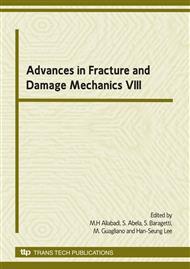p.333
p.337
p.341
p.345
p.349
p.353
p.357
p.361
p.365
Numerical Interpretation of Bond Between Steel and Concrete in Presence of Corrosion and Cyclic Action
Abstract:
Bond between steel and concrete in reinforced concrete structures plays a fundamental role. The stress transfer mechanism depends on the condition of the contact surface between the two materials, the mechanical characteristics of concrete near the rebar and on the available level of confinement. Corrosion of reinforcing bars in concrete structures modifies those three factors. Because of corrosion, on the rebar surface a granular oxide layer is present and with its expansion it generates a significant radial pressure; consequently tensile stresses grow till cracking of the concrete cover with a subsequent reduction of the confinement effect. Moreover the presence of a mechanical action modifies the resisting mechanism producing an increasing damage. In this study, a model is presented for the numerical simulation of experimental tests on r.c. ties subjected to mechanical action; furthermore some considerations on reinforced concrete ties subjected also to corrosion effect are reported. From those analyses it is possible to estimate a modified bond-slip law between the reinforcing bars and the concrete, in order to take into account the level of damage.
Info:
Periodical:
Pages:
349-352
Citation:
Online since:
October 2009
Authors:
Keywords:
Price:
Сopyright:
© 2010 Trans Tech Publications Ltd. All Rights Reserved
Share:
Citation:


